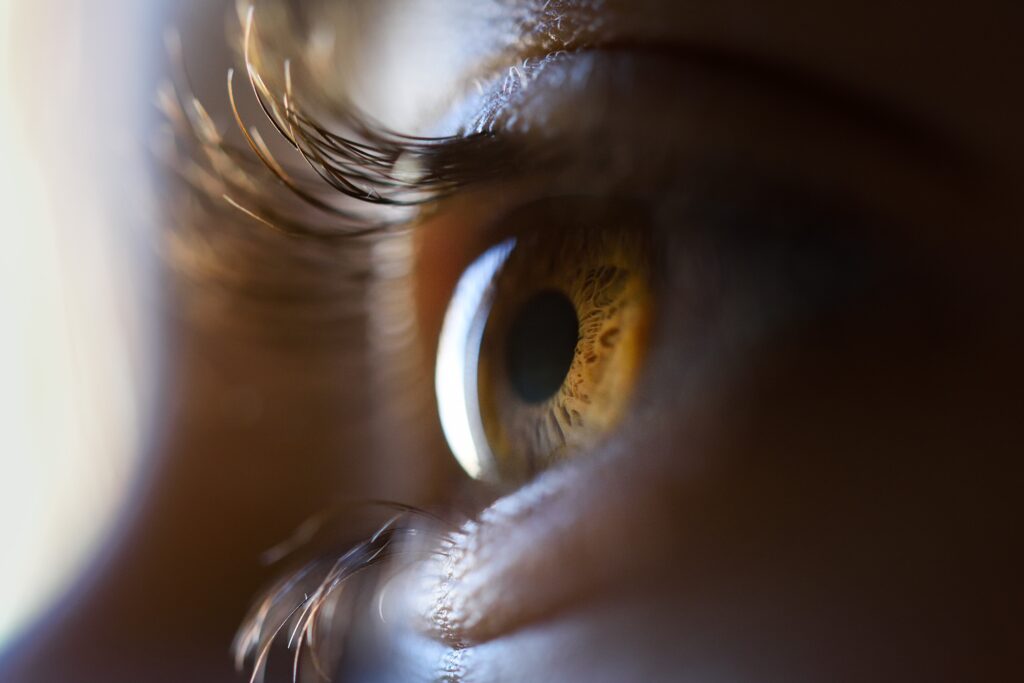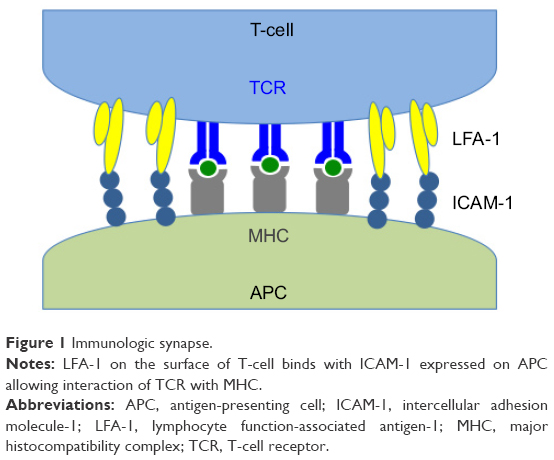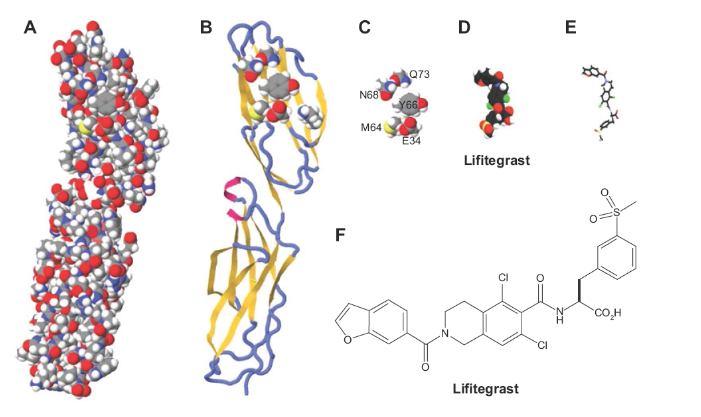In the Blink of an Eye: Lifitegrast for Dry Eyes
(Posted on Tuesday, July 25, 2023)
Originally published on Forbes on 7/20/2023

Close-up of beautiful little girl brown eye. Macro photograph.
Burning, itching, watering eyes. Few things are a bigger nuisance than irritated eyes, so it’s no surprise there are so many options for dry eye relief. While various treatment options are available for dry eyes, not all treatments are created equal in effectiveness and addressing the underlying causes of dry eyes.
Mechanisms behind dry eyes include meibomian gland dysfunction, tear film dysfunction, decreased tear production, increased tear evaporation, and autoimmune diseases. Dry eyes occur when tears fail to provide adequate lubrication.
This article will explore the effectiveness and drawbacks of artificial tears versus anti-inflammatory drops like the recently approved Xiidra® in managing this common condition.
You Can Cry If You Want To: Artificial Tears for Dry Eyes
One of the most commonly used treatments for dry eyes is artificial tears. These eye drops add moisture to the eyes and improve tear film stability, temporarily relieving mild dry eye symptoms.
The drawback to artificial tears is that they can only provide temporary relief and do not treat the underlying issues. This reprieve from symptoms also leads to frequent use of these tears, which often contain preservatives that may cause eye irritation and redness with prolonged use. Some people also experience changes in vision or eye pain after using artificial tears for an extended time. Moreover, additional therapies may need to be administered with artificial tears to maximize the treatment’s effectiveness.
Unlike artificial tears, other medications, such as anti-inflammatory eye drops, target the root causes of dry eyes, providing more comprehensive relief.
Anti-Inflammatory Options for Irritated Dry Eyes
Anti-inflammatory eye drops, on the other hand, target the root causes of dry eyes, providing more comprehensive relief than artificial tears. One such medication is Xiidra®, a lifitegrast ophthalmic solution specifically designed to treat the signs and symptoms of dry eyes.
Clinical trials involving 2133 patients with dry eyes evaluated Xiidra®’s effectiveness in managing dry eyes. These trials typically involve a group of randomly assigned participants to receive either Xiidra® or a placebo. The participants’ symptoms and eye health are monitored over a period of time to assess the drug’s efficacy. The trials measured the improvement of dry eye disease using an inferior fluorescein corneal staining score and patient symptoms reported via an eye dryness score.
The medication effectively reduces dry eye symptoms and improves eye health, as found in three studies conducted to ensure the safety and efficacy of the drops: OPUS-1, OPUS-2, and OPUS-3. Xiidra outperformed placebo remedies significantly in all three studies, reducing the signs and symptoms of dry eye disease. Patients who received ongoing lifitegrast treatment exhibited a reduction in dry eye disease symptoms at 3, 6, and 12 months following the initial treatment. Also, symptom questionnaire scores showed a consistent decline at 3, 6, and 12 months after the index compared to before.
In addition to these clinical trials, a pooled analysis of five randomized controlled trials published in Drugs evaluated the safety and tolerability of the medication. Xiidra® was generally well tolerated, with mild side effects like eye irritation and redness. While Xiidra® may have limitations and potential side effects, it offers hope for individuals seeking long-lasting relief from dry eye disease.
How Does Xiidra Work?
Xiidra® works by targeting the interaction between two proteins. It specifically targets the interaction between lymphocyte function-associated antigen-1 (LFA-1) and intercellular adhesion molecule 1 (ICAM-1). Both of these proteins play a role in inflammation and immune responses.
LFA-1 is expressed on the surface of specific white blood cells, while ICAM-1 is on the surface of various cells in the eye. When LFA-1 and ICAM-1 interact, it can lead to inflammation and worsening dry eye symptoms. By blocking this interaction, Xiidra® helps reduce inflammation and improve tear production.

The development of lifitegrast, the active ingredient in Xiidra®, involved targeting the interaction between lymphocyte function-associated antigen-1 (LFA-1) and intercellular adhesion molecule 1 (ICAM-1) to reduce inflammation and immune responses associated with dry eye disease.
The figure below illustrates the evolution of the lifitegrast design. The first two domains of ICAM-1 were determined by X-ray crystallography and are shown in a space-filling model represented by part a. The binding residues in domain 1 are superimposed on a ribbon diagram of the first two domains of ICAM-1 as represented by part b of the figure.
The six amino acid side chain binding residues identified by alanine point mutagenesis of the ICAM-1 epitope that binds to LFA-1 are depicted in another space-filling depiction as seen in part c. The molecular structure of lifitegrast is represented using a space-filling model as seen in part d of the figure. Part e shows the three-dimensional structural form of lifitegrast. Finally, the structural formula of lifitegrast is shown in part f of the image.

Lifitegrast binds to the integrin LFA-1 found on the surface of white blood cells. By binding to this protein, lifitegrast blocks the interaction between LFA-1 and ICAM-1, disrupting the subsequent cycle of t-cell-mediated inflammation that can lead to dry eye disease.
Blocking the interaction reduces the migration of white blood cells into ocular tissues and alleviates dry eye inflammation. Lifitegrast also facilitates the cell-mediated elimination of cytotoxic T-cells, granulocytes, and monocytes. This elimination of cytotoxic cells further reduces inflammation by reducing the production of inflammatory cytokines.
In addition to its anti-inflammatory properties, lifitegrast increases tear production by upregulating the expression of MUC5AC, a gene associated with mucous secretion in the conjunctival epithelium. Increased mucous production leads to increased moisture on the ocular surface and relief from dryness.
Other Anti-Inflammatory Options
In addition to Xiidra®, other anti-inflammatory eye drops are available for treating dry eyes. Restasis® is another prescription eye drop that increases tear production and reduces inflammation. A third anti-inflammatory eye drop called Eysuvis is also available, though it is only recommended for short term use. These products are usually applied twice a day and can effectively alleviate symptoms of dry eyes and they offer more comprehensive relief for dry eyes than artificial tears. While they may have limitations and potential side effects, there is hope for individuals seeking long-lasting relief from dry eye disease.
Medical advances, like anti-inflammatory eye drops, will continue to push us toward a future without dry, irritated eyes. We need only wait and see.
To learn more about the eye, read more stories at www.williamhaseltine.com

